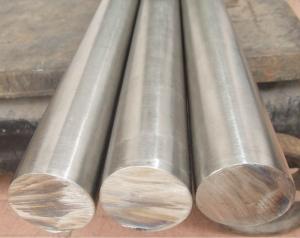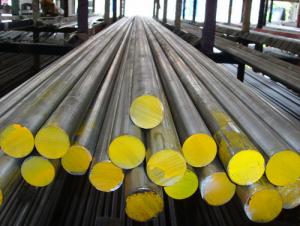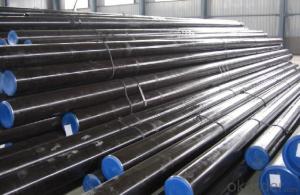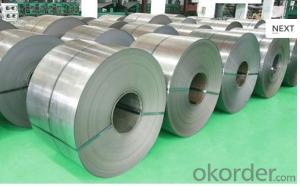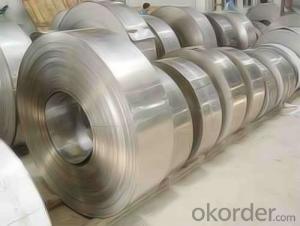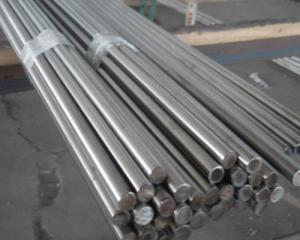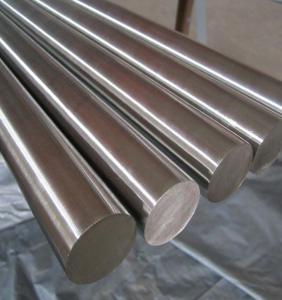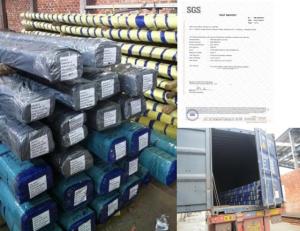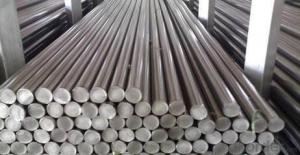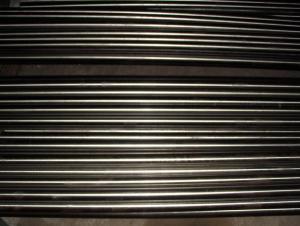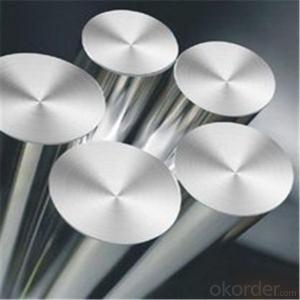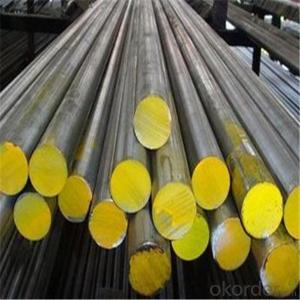Stainless Steel Bars
- Loading Port:
- Shanghai Port
- Payment Terms:
- TT or LC
- Min Order Qty:
- 10 Tons m.t.
- Supply Capability:
- 1000 Tons Per Month m.t./month
OKorder Service Pledge
OKorder Financial Service
You Might Also Like
Introduction of Stainless Steel Round Bright Bar:
Stainless steel is a production which not easy rust,acid resistance and corrosion resistance, so it is widely used in light industry, heavy industry, daily necessities and the decoration industry.my company long-term supply stainless steel porducts including: stainless steel sheet, stainless steel coil and stainless steel tube.
Details of Stainless Steel Round Bright Bar(Cold Drawing Polished):
*DIA 10mm to 130mm
*FORGE
*DIA 130mm to 300mm
*GB1220,ASTM A 484/484M, EN 10060/ DIN 1013
*DIA 3mm to 60mm
Main operation | Main steel grade | Available size(mm) | Monthly capacity(mt) | Length(mm) | |
OEM | Stainless steel | 40~500 | 1500 | 4000~8000 | |
Hot | 303 303Cu 304/L 310S 316/L 321 416 420 | 12 ~200 | 3000 | 4000~7000 | |
17-4PH WLA510 | 19~110 | 2000 | 4000~7000 | ||
ST Bar | 321 304/L 316/L 310S 17-4PH WLA510 | 19~110 | 2000 | 4000~7000 | |
CD Bar | Round bar | 303 303CU 304/L 316/L 416 420 17-4PH WLA510 | 4.76~100 | 500 | 2500~6500 |
Square bar | 303 303CU 304/L 316/L 416 17-4PH WLA510 | 4.76~75 | 180 | 2500~6500 | |
Hex bar | 303 303CU 304/L 316/L 416 17-4PH WLA510 | 4.76~75 | 180 | 2500~6500 | |
CG Bar | 303 303CU 304/L 316/L 416 420 17-4PH WLA510 | 4.76~100 | 500 | 2500~6500 | |
Features of Stainless Steel Round Bright Bar:
*Low density
*High specific strength
*High corrosion resistance
*Good thermal stability and plasticity
*It is widely applied for petroleum, chemical, mechanical and electrical, hardware, etc.
Quality assurance of Stainless Steel Round Bright Bar:
All of the products are detected by ultrasound making sure that no defects inside the products. Besides, chemical composition, mechanical properties and high-powered organization are also strictly controlled, ensuring our clients get the best products.
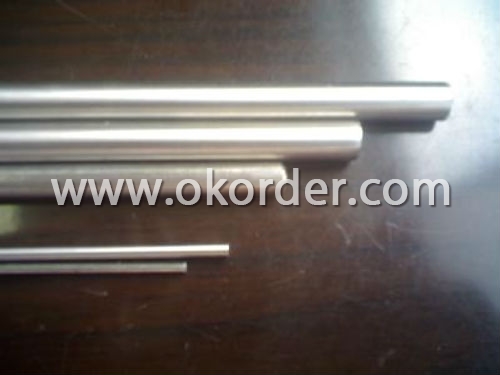
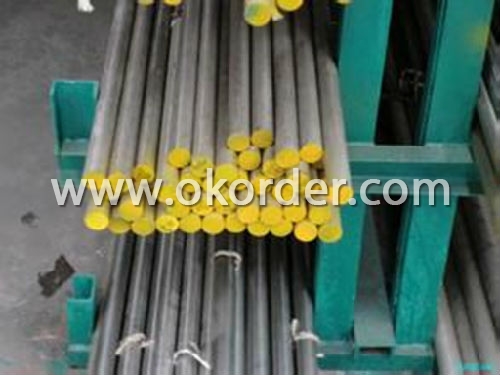
- Q:What is the difference between centerless ground and peeled stainless steel bars?
- The main difference between centerless ground and peeled stainless steel bars lies in the manufacturing process. Centerless ground bars are produced by grinding the surface of the stainless steel bar to achieve precise dimensions and a smooth finish. This process removes any imperfections and ensures tight tolerances. On the other hand, peeled stainless steel bars are created by removing the outer layer of the stainless steel bar through a peeling process. This results in a smooth, clean surface while retaining the original size of the bar. Overall, centerless ground bars are more suitable for applications that require precise dimensions, while peeled bars are preferred when a smooth surface finish is the main requirement.
- Q:What are the different machining techniques for stainless steel bars?
- There are several machining techniques that can be used for stainless steel bars, depending on the desired outcome and the specific requirements of the project. Some common machining techniques for stainless steel bars include: 1. Turning: This technique involves rotating the stainless steel bar against a cutting tool to remove material and create a desired shape or diameter. Turning is a versatile technique that can be used to create cylindrical shapes, threads, and other intricate features. 2. Milling: Milling is a process that involves using a rotating cutting tool to remove material from the surface of the stainless steel bar. It can be used to create flat surfaces, slots, pockets, and other complex shapes. Milling can be performed using various machines, such as vertical milling machines or CNC milling machines. 3. Drilling: Drilling is a technique that involves creating holes in the stainless steel bar using a rotating cutting tool. It is commonly used to create round holes of different diameters and depths. Drilling can be performed manually or using drilling machines that provide more precise control. 4. Grinding: Grinding is a machining technique that involves using an abrasive wheel to remove material from the surface of the stainless steel bar. It is often used to achieve tight tolerances, smooth finishes, and precise dimensions. Grinding can be performed using different types of grinding machines, such as surface grinders or cylindrical grinders. 5. Boring: Boring is a machining technique that involves enlarging existing holes or creating larger diameter holes in the stainless steel bar. It is commonly used to achieve precise dimensions and tight tolerances. Boring can be performed using specialized boring machines or using a lathe with a boring bar. 6. Broaching: Broaching is a machining technique that involves using a broach, which is a cutting tool with multiple teeth, to remove material from the stainless steel bar. It is commonly used to create keyways, splines, and other intricate shapes. Broaching can be performed using vertical or horizontal broaching machines. 7. Sawing: Sawing is a technique that involves using a saw with a rotating blade to cut through the stainless steel bar. It can be used to create straight cuts, angled cuts, or to separate the bar into multiple pieces. Sawing can be performed using manual saws, band saws, or circular saws. These are just some of the machining techniques that can be used for stainless steel bars. The specific technique or combination of techniques will depend on the desired outcome, the size and shape of the bar, and the equipment available. It is important to select the appropriate machining technique to ensure the desired results are achieved efficiently and accurately.
- Q:Can stainless steel bars be used in the food and beverage aftermarket?
- Indeed, the food and beverage aftermarket can utilize stainless steel bars. Due to its hygienic properties, durability, and resistance to corrosion, stainless steel is widely favored for food and beverage equipment. In the construction of food processing equipment, bar counters, kitchen equipment, and beverage dispensers, stainless steel bars are frequently employed. Their ease of cleaning and maintenance renders them appropriate for applications that prioritize cleanliness and sanitation. Furthermore, stainless steel does not react with food and does not release any harmful substances, guaranteeing that the quality and flavor of the food or beverages remain unaffected.
- Q:What is the weight of a standard stainless steel bar?
- The weight of a standard stainless steel bar can vary depending on its length, diameter, and specific grade of stainless steel.
- Q:What are the different shapes available for stainless steel square bars?
- There are various shapes of stainless steel square bars available to suit different applications and preferences. Some common shapes are as follows: 1. Square: This shape is the most basic and traditional for stainless steel square bars. It has four equal sides and right angles, making it suitable for a wide range of structural and decorative purposes. 2. Round-edged square: Also known as chamfered square bars, these have rounded edges instead of sharp corners. The rounded edges provide a more aesthetically pleasing appearance while maintaining the strength and durability of the stainless steel. 3. Half-round: These square bars have a semi-circular profile on one side, while the other side remains flat. This shape is commonly used in architectural and decorative applications, as it adds a unique and visually appealing element to the design. 4. Hexagonal: Hexagonal stainless steel square bars have six sides, forming a regular hexagon shape. This shape offers increased surface area compared to square bars, making it suitable for applications that require enhanced gripping capabilities or increased structural stability. 5. Tapered: Tapered square bars have one end wider than the other, gradually decreasing in width along the length of the bar. This shape is often used in structural applications where the load needs to be distributed gradually or for aesthetic purposes to create a unique visual effect. It is important to note that the availability of these shapes may vary depending on the supplier or manufacturer. It is advisable to consult with a stainless steel supplier to determine the specific shapes they offer and to ensure they meet the requirements of your intended application.
- Q:Can stainless steel bars be used in construction?
- Yes, stainless steel bars can be used in construction. Stainless steel is a highly versatile material that possesses excellent corrosion resistance, durability, and strength properties. It is particularly useful in construction applications where the bar needs to withstand harsh environmental conditions, such as in coastal areas or industrial settings. Stainless steel bars are commonly used for reinforcement in concrete structures, such as bridges, buildings, and highways. They are also utilized in various architectural and decorative aspects of construction, including handrails, balustrades, and facades. Additionally, stainless steel bars have a long lifespan, require minimal maintenance, and can be easily fabricated to meet specific project requirements.
- Q:Are stainless steel bars suitable for guitar strings?
- Stainless steel bars do not make suitable guitar strings, as they lack the necessary flexibility and hardness. Although stainless steel is known for its durability and resistance to corrosion, it does not meet the requirements for guitar strings. To achieve the desired sound and feel while playing, guitar strings must have a certain level of flexibility. While stainless steel strings are often chosen for their bright and aggressive tone, they are usually wrapped around a core made of a more flexible material, like nickel or steel. If stainless steel bars were used as guitar strings, the playing experience would be harsh and uncomfortable, and there is also a risk of damaging the instrument.
- Q:What are the different types of corrosion-resistant stainless steel bars?
- In the market, one can find various types of stainless steel bars that are resistant to corrosion. These bars can be categorized as follows: 1. Austenitic Stainless Steel Bars: These bars are extensively used due to their high resistance to corrosion. They are widely utilized in various applications. The presence of substantial amounts of chromium and nickel in these bars provides exceptional resistance to corrosion in different environments. 2. Ferritic Stainless Steel Bars: These bars also offer good resistance to corrosion, although not as high as austenitic stainless steel. They contain lower levels of nickel and are primarily composed of chromium. As a result, they are suitable for applications that require moderate resistance to corrosion. 3. Martensitic Stainless Steel Bars: With higher carbon content, these bars are renowned for their strength and hardness. They provide decent resistance to corrosion and are commonly employed in applications where strength and wear resistance are crucial. 4. Duplex Stainless Steel Bars: These bars are a combination of austenitic and ferritic stainless steels, which results in excellent corrosion resistance and high strength. They are particularly suitable for applications involving chloride-containing environments, such as marine environments or sewage treatment plants. 5. Precipitation-Hardening Stainless Steel Bars: Known for their high strength and good corrosion resistance, these bars can undergo heat treatment to achieve even greater strength. They are ideal for applications where both strength and corrosion resistance are important. When selecting a corrosion-resistant stainless steel bar, it is essential to consider the specific requirements of the application. Factors such as the environment, temperature, and exposure to chemicals or moisture should be taken into account to ensure the appropriate type of stainless steel is chosen.
- Q:What is the difference between hot extruded and cold extruded stainless steel bars?
- The main difference between hot extruded and cold extruded stainless steel bars lies in the manufacturing process. Hot extrusion involves heating the stainless steel material to high temperatures and then forcing it through a die to shape it into a bar. This process helps to improve the overall strength and ductility of the stainless steel bar. On the other hand, cold extrusion involves shaping the stainless steel material at room temperature or slightly elevated temperatures. This process is more commonly used for smaller and more intricate designs. While it may not enhance the strength and ductility of the stainless steel bar as significantly as hot extrusion, cold extrusion can still produce high-quality bars with precise dimensions and excellent surface finish.
- Q:What are the different types of stainless steel bars used in marine environments?
- Various stainless steel bars are widely used in marine environments because of their ability to resist corrosion. These bars can be categorized into several types: 1. Austenitic Stainless Steel: This type is the most commonly chosen for marine applications due to its corrosion resistance. It is also highly weldable and formable. The preferred grade for marine environments is 316 stainless steel, which contains molybdenum to enhance its resistance to pitting and crevice corrosion. 2. Duplex Stainless Steel: Combining austenitic and ferritic stainless steels, this type offers higher strength and better resistance to stress corrosion cracking compared to austenitic stainless steel. Duplex grades like 2205 are frequently utilized in marine environments that demand high strength and corrosion resistance. 3. Martensitic Stainless Steel: Known for its high strength and hardness, this type is less corrosion-resistant than austenitic or duplex stainless steels. However, it can still be used for certain marine applications. Grades like 410 and 420 are commonly employed for marine shafts and propellers. 4. Precipitation Hardening Stainless Steel: Also known as PH stainless steel, this type provides a combination of high strength and corrosion resistance. It can be heat-treated to achieve different levels of hardness and toughness. PH grades like 17-4PH are used in marine environments where strength and corrosion resistance are crucial. 5. Super Duplex Stainless Steel: This highly alloyed version of duplex stainless steel offers superior corrosion resistance and higher strength compared to standard duplex grades. Super duplex grades like 2507 are commonly used in aggressive marine environments where resistance to corrosion, erosion, and pitting is essential. When selecting the appropriate stainless steel bar for a marine application, it is important to consider factors such as exposure to saltwater, temperature fluctuations, and mechanical stresses. By evaluating the specific marine environment and the severity of conditions, the right stainless steel grade can be chosen.
1. Manufacturer Overview |
|
|---|---|
| Location | Wuxi,China |
| Year Established | 2003 |
| Annual Output Value | Above US$8.3 Million |
| Main Markets | SouthEast Asia |
| Company Certifications | ISO9001:2000 |
2. Manufacturer Certificates |
|
|---|---|
| a) Certification Name | |
| Range | |
| Reference | |
| Validity Period | |
3. Manufacturer Capability |
|
|---|---|
| a)Trade Capacity | |
| Nearest Port | Shanghai |
| Export Percentage | 30% |
| No.of Employees in Trade Department | 30 People |
| Language Spoken: | English;Chinese |
| b)Factory Information | |
| Factory Size: | Above21,000 square meters |
| No. of Production Lines | Above 7 |
| Contract Manufacturing | OEM Service Offered;Design Service Offered |
| Product Price Range | Average |
Send your message to us
Stainless Steel Bars
- Loading Port:
- Shanghai Port
- Payment Terms:
- TT or LC
- Min Order Qty:
- 10 Tons m.t.
- Supply Capability:
- 1000 Tons Per Month m.t./month
OKorder Service Pledge
OKorder Financial Service
Similar products
New products
Hot products
Related keywords





